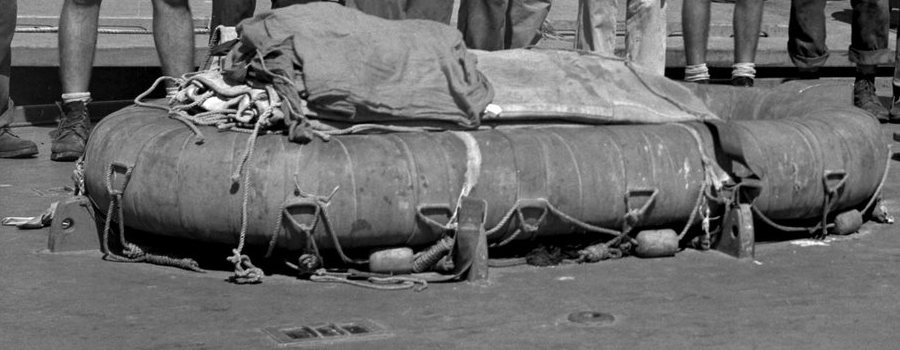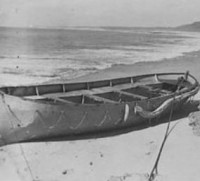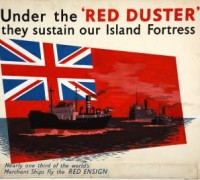SURVIVORS ADRIFT IN SOUTH ATLANTIC * - SURVIVORS
1)CARLEY FLOAT

Photo. http://www.pt103.com/Italeri_PT109_Kit.html
CARLEY FLOAT
Carley float The (sometimes Carley raft) was a form of invertible liferaft designed by American inventor Horace Carley (1838–1918). Supplied mainly to warships, it saw widespread use in a number of navies during peacetime and both World Wars until superseded by more modern rigid or inflatable designs. Carley was awarded a patent in 1903 after establishing the Carley Life Float Company of Philadelphia.
The Carley float was formed from a length of copper or steel tubing 12–20 inches (30–50 cm) in diameter bent into an oval ring. The ring was surrounded by a buoyant mass of kapok or cork, and then covered with a layer of canvas rendered waterproof via painting or doping. The metal tube was divided into waterproof compartments with vertical baffles. The raft was thus rigid, and could remain buoyant, floating equally well with either side uppermost, even if the waterproof outer was punctured. The floor of the raft was made from a wood or webbing grating. Boxes containing paddles, water, rations and survival equipment were lashed to the floor grating. Men could either sit around the rim of the raft, or, if in the water, cling to rope loops strung around its edge. The largest model could accommodate up to fifty men, half inside the raft, and the others in the water holding onto the ropes.
Some variants included a calcium flare that would automatically ignite on immersion in water. The flare could however expose a raft to hostile fire, as then-Lt. Stuart Bonham Carter found during the 1918 Zeebrugge Raid as he escaped the scuttled blockship HMS Intrepid. Only the smoke of the burning vessel behind him prevented him from being targeted.
Simply by casting it over the side, the lightweight Carley float could be launched more rapidly than traditional rigid lifeboat designs, and without the need for specialised hoists. It could be mounted on any convenient surface and survive the battering against the ship's sides during heavy seas. Unlike the rubber inflatable rafts of the period, it was relatively immune to compromise of its buoyant chambers. Seafarers in it were however completely exposed to the elements, and would suffer accordingly. An inquiry of 1946 reported that many sailors who had succeeded in getting to the safety of Carley floats had nevertheless succumbed to exposure before rescue could be made. The crew of the Canadian minesweeper HMCS Esquimalt, sunk offshore of Nova Scotia in April 1945, lost at least 16 to hypothermia during the six hours in which they awaited rescue. Few of the survivors could still walk.
Despite these shortcomings many seamen did owe their lives to the Carley float. Chinese sailor Poon Lim survived for a record 133 days adrift in the South Atlantic aboard a Carley float after his freighter SS Ben Lomond was sunk on 23 November 1942. He fashioned fishing gear from components of the raft. He was close to death when discovered off the coast of Brazil on 5 April 1943, but was able to walk ashore unaided.
Though its occupant did not survive, a shrapnel-ridden Carley float carried the body of an unknown man to land on Christmas Island in February 1942. The sun-bleached corpse had evidently spent a lengthy period at sea, though to this day it remains unknown from where the sailor had come. It has long been suspected that the body was that of a sailor from HMAS Sydney, which was lost with all hands under mysterious circumstances off the coast of Australia on 19 November 1941. A second Carley float, more confidently believed to be from Sydney, was recovered drifting 300 km off the Australian coast one week after the ship sank. It had been badly damaged by shellfire, but was empty. The float is now displayed at the HMAS Sydney exhibit of the Australian War Memorial, Canberra.
By https://en.wikipedia.org/wiki/Carley_float


